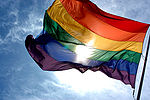Gay village
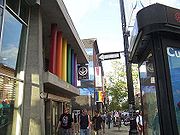
A gay village (also known as a gay neighborhood, gay ghetto or by the slang gayborhood) is an urban geographic location with generally recognized boundaries where a large number of lesbian, gay, transgender, and bisexual people live or frequent. Gay villages often contain a number of gay-oriented establishments, such as gay bars and gay pubs, nightclubs, bathhouses, restaurants, and bookstores.
Such areas may represent a gay-friendly oasis in an otherwise hostile city, or may simply have a high concentration of gay residents and/or businesses. Much as other urbanized groups, some gay men and women have managed to utilize their spaces as a way to reflect gay cultural value and serve the special needs of individuals in relation to society at large.
Typically, today, these neighborhoods can be found in the upscale or trendy parts of town, chosen for aesthetic or historic value, no longer resulting from the sociopolitical ostracization and the constant threat of physical violence from heterosexuals that originally motivated the homosexual communities to live together for their mutual safety.
However, these neighborhoods are also often found in working-class parts of the city, or in the neglected fringe of a downtown area – communities which may have been upscale historically but became economically depressed and socially disorganized. In these cases, the establishment of a gay community may eventually turn these areas into desirable, upscale neighborhoods, a process known as gentrification – a phenomenon in which gays often play a pioneer role.[1] However, this process does not always work out to the benefit of queer communities, as they often see property values rise so high that they can no longer afford them as high rise condominiums are built and gay bars move out. (Or the only gay establishments that remain are those catering to a more upscale clientele.)
Today's manifestations of gay "ghettos" bear little resemblance to those of the 1970s.[2]
Contents |
The "ghetto"
The term "ghetto" originally referred to those places in European cities where Jews were required to live. During the 20th century, the term ghetto came to be used to describe the areas inhabited by a variety of groups that mainstream society deemed outside the norm, including not only Jews, but poor people, gay men and lesbians, racial minorities, hobos, prostitutes, and bohemians.
These neighborhoods, which often arise from zones of discard — that is, crowded, high density, and often deteriorated inner city districts — are critical sites where members of gender and sexual minorities congregate. From one perspective, these spaces are places of marginality created by an often homophobic heterosexual community; from another perspective, they are places of refuge where members of gender and sexual minorities can benefit from the concentration of safe, non-discriminatory resources and services (just as other minorities do).
In some cities, gays and lesbians congregate in visibly identified gay neighborhoods, while in other cities they are dispersed in neighborhoods which have less gay visibility because a liberal, affirming counterculture is present. For example, gays and lesbians in San Francisco congregate in the gay and lesbian-oriented Castro neighborhood, while gays and lesbians in Seattle concentrate in the city's older bohemian stomping grounds of Capitol Hill and those of Montreal have concentrated in a working-class neighbourhood referred to administratively as "Centre-Sud", but largely known as "Le Village". These areas, however, have higher concentrations of gay and lesbian residents and businesses that cater to them than do surrounding neighborhoods.
History of the gay village
Prior to the 1960s and 1970s, specialized gay communities did not exist as such; bars were usually where gay social networks developed, and they were located in certain urban areas where police zoning would implicitly allow so-called "deviant entertainment" under close surveillance. In New York, for example, the congregation of gay men had not been illegal since 1965; however, no openly gay bar had been granted a license to serve alcohol. The police raid of a private gay club called the Stonewall Inn on June 27, 1969 led to a series of minor disturbances in the neighborhood of the bar over the course of the subsequen three days involving over 1000 people. Stonewall managed to change not only the profile of the gay community but the dynamic within the community itself. This along with several other similar incidents precipitated the appearance of gay ghettos throughout North America, as spatial organization shifted from bars and street-cruising to specific neighbourhoods. This transition "from the bars to the streets, from nightlife to daytime, from 'sexual deviance' to an alternative lifestyle" was the critical moment in the development of the gay community.[3]
Characteristics
Gentrification
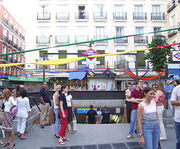
The gentrification of some urban neighbourhoods has been catalysed by gay villages. Certain patterns of residential development are particular to the community.
The gentrification is linked, in part, to changing national and global economies, and in particular to the social and spatial restructuring of labor processes. Heavy industry has been leaving North America for developing countries or leaving central business districts (CBDs) for suburban areas, seeking, in both cases, cheaper land, labor, and tax costs. Conversely, the service sector has been steadily expanding, and investment in high-tech industries has increased. Much of the new corporate-managerial and service-sector investment has tended to be, not insignificantly, in the CBDs of large cities, and these sectors have also tended to employ large proportions of low-wage and/or part-time labor, much of it female. The expansion of these jobs in CBDs has constituted a significant part of the economic pull-factor to urban areas for lesbians and gay men, complementing the attraction of the cities as centres of gay life.
Mickey Lauria and Lawrence Knopp, professors at the University of New Orleans and University of Minnesota respectively, tie these processes to the spatial nature of the urban renaissance which was occurring at the time. They argue that the "first wave" of low-wage gay residences in these urban centers paved the way for other, more affluent gay professionals to move into the neighborhoods; this wealthier group played a significant role in the gentrification of many inner city neighborhoods. The professors also noted that the presence of gay men in the real estate industry of San Francisco was a major factor facilitating the urban renaissance of the city in the 1970s.
However, the gentrification of gay villages may also serve to reinforce stereotypes of gays, by pushing out gay people who do not conform to the prevailing "gay, white, affluent, professional" image. Such people (including gay people of color, low-income/working-class gays, and "undesirable" groups such as gay prostitutes, leathermen, and transsexuals) are usually forced out of the "village" due to rising rents or constant harassment at the hands of an increased policing presence. Especially in San Francisco's Polk Gulch neighborhood (ironically, the first "gay village" in that city), gentrification has had a devastating effect.[4]
Consumerization
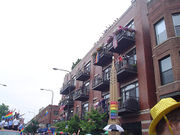
The gentrification of once run-down inner-city areas, coupled with the staging of pride parades in these areas, has resulted in the increased visibility of gay communities. Parades such as Sydney's Gay and Lesbian Mardi Gras and Manchester's Pride events attract significant investment and create tourist revenue, and cities are beginning to realize, firstly, that the acceptance of lesbian and gay culture is fast becoming a sign of urban "sophistication", and secondly, that gay-oriented events, such as pride parades, the World Outgames and the Gay Games, are potentially lucrative events, attracting thousands of gay tourists and their dollars. The growing recognition of the economic value of the gay community is not only associated with their wealth but also with the role that lesbians and gay men have played (and continue to play) in urban revitalization.
Some cities have taken it upon themselves to create a gay villages to capitalize on gay dollars. In 2004, Oakland, California tried to create a village in a run-down portion of the city in an attempt to divert residents, entertainment, and shopping dollars from neighboring San Francisco. The project has achieved mixed results as that Oakland's gay community is spread out over a wide area.
List of gay villages
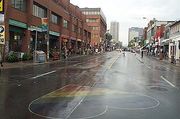
Gay villages can vary widely from city to city and country to country. Furthermore, some large cities develop "satellite" gay villages that are essentially "overflow" areas; in such cases, lesbians and gay men become priced-out of gentrified gay villages and move to other, more affordable areas, thereby creating entirely new gay villages. Some of the listed gay villages are technically not neighborhoods of a larger city but a separate entity entirely from the city for which they are the primary gay enclave, e.g., West Hollywood in Los Angeles, California and Wilton Manors in Florida.
Some cities have a well-defined gay village in the heart of a larger area with a significant gay population that would not necessarily be considered a gay village. For example, Davie Village is the heart of Vancouver's gay community, but sits within the greater West End area, which, though decently populated by gay people, is not necessarily considered a gay village. Other examples of this phenomenon include Boystown, Chicago, a well-defined gay village situated in the larger Lakeview community. Lakeview has a reputation for being a stronghold of liberal and progressive political views, but is far from exclusively gay, as a large number of straight families call the neighborhood home. Similarly, despite its predominantly gay population and higher concentration of gay venues, the South Beach area in Miami Beach, Florida, was never exclusively gay, because of its popularity among straight people alike. Philadelphia's gay village comprises downtown blocks from about 11th and Walnut to 13th and Lombard and is called "the Gayborhood". It is known for a wide range of clubs, bars, and restaurants along with LGBT health facilities. Baltimore's Mount Vernon neighborhood has long been a gay village known for its gay bars that run up and down Charles Street. Due to the neighborhoods cleanliness, vast array of fabulous restaurants, and refurbished historic housing a large population of straight young professionals are now calling Mt. Vernon home. The straight and gay community within Mt. Vernon are very symbiotic and embrace individuality and personal expression. Washington DC's Dupont Circle and Logan Circle area are known for its many gay oriented bars, restaurants, and shops. The Short North in downtown Columbus, Ohio is primarily known as an art district, but has a strong gay community and a high concentration of gay-oriented clubs and bars. In Boston, the trendy and upscale South End neighborhood has a large population of gay men, and the Jamaica Plain and Roslindale neighborhoods are home to scores of lesbians, also with vibrant but less trendy downtown areas.
Montreal's Gay Village (Le Village, in French) is considered one of North America's largest in population, concentration and scope.
Some areas are often associated with being "gay" cities or resorts, due to their image and acceptance of the gay community. Examples include San Francisco, Manchester and Brighton in the UK, Sydney, Cape Town and the Greek island of Mykonos. Manchester's gay village (like many) is within Greater Manchester's main central business district and is the centre for the city's pride events. The village is based on Canal Street, so The Gay Village and Canal Street are terms used interchangeably when describing the area. The Queer as Folk storyline was set in Manchester and much of the series was filmed in the city's gay village. Gay scenes from Britain's ITV serial drama Coronation Street (also based in the city) were filmed around Canal Street.
The neighbourhood of Le Marais in Paris has experienced a growing gay presence since the 1980s, as evidenced by the existence of a big gay community and of many gay cafés, nightclubs, cabarets and shops, such as the biggest Gay Club in Europe called Le Depot. These establishments are mainly concentrated in the southwestern portion of the Marais, many on or near the streets Sainte-Croix de la Bretonnerie and Vieille du Temple.
San Diego has its own gay village called "Hillcrest", which sits around Balboa Park. Hillcrest is very close to the downtown area but is able to maintain a small town eclectic feel. While it is considered by most as the gay area of San Diego with its gay bars and dance clubs, the overall population of the area has only gotten more and more diverse with the rise in condominium projects.
In Minneapolis, Minnesota areas surrounding Loring Park, site of the local LGBT pride festival, are regarded as a "gay" neighborhood, though many gay and lesbian people have migrated to more residential neighborhoods such as Bryn Mawr and Whittier.
In Tampa, Florida, the gay community was traditionally spread out among several neighborhoods. In the early twenty first century, the Ybor City National Historic Landmark District has seen the creation of the GaYbor District, which is now the center of gay and lesbian life in the Tampa Bay area and home to the majority of gay bars and dance clubs, restaurants, and service organizations.
Church and Wellesley is an LGBT-oriented community located in Toronto, Ontario, Canada. It is roughly bounded by Gould Street to the south, Yonge Street to the west, Charles Street to the north, and Jarvis Street to the east, with the intersection of Church and Wellesley Streets at the centre of this area. Though some gay and lesbian oriented establishments can be found outside of this area, the general boundaries of this village have been defined by the Gay Toronto Tourism Guild.[5] Many LGBT people also live in the nearby residential neighbourhoods of The Annex, Cabbagetown, St. James Town and Riverdale, and in smaller numbers throughout the city and its suburbs.
Asbury Park, New Jersey and the adjacent town of Ocean Grove, New Jersey house a large gay community. Many vacationers who visit Asbury Park are gay, and the city houses New Jersey's only gay hotel, The Empress Hotel. Collingswood, New Jersey, a suburb of Philadelphia, also houses a very large year round gay community.
In some cities, such as Stockholm, Helsinki and Copenhagen, there are no established gay villages, partly due to the differing social dynamics of these cities (less social segregation within the city), but also due to earlier and greater social acceptance of the gay community within mainstream society. However there are areas which were historically known as meeting places for gays, such as Södermalm in Stockholm, which remains a somewhat trendy area for gay people to live, though it does not have a predominantly gay population.
In other cities, gay villages are less obviously residential in nature, because of the shortage of accommodation, the high price of real estate, and long-established existing communities.
LGBT populations
Top LGBT populations in Brazilian cities
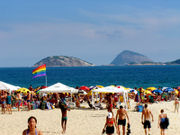
In 2009, a survey conducted by the University of São Paulo in 10 Brazilian state capitals, estimated that 7.8% of Brazil's male population was gay and 2.6% was bisexual (a total of 10.4%), while 4.9% of the female population was estimated to be lesbian and 1.4% bisexual (a total of 6.3%).[6]
In the city of Rio de Janeiro 19.3% of the male population was estimated to be gay or bisexual. Among the female population in the city of Manaus, 10.2% were estimated to be lesbian or bisexual.[6]
| Rank | City | Percentage of City Population |
GLB Population | |
|---|---|---|---|---|
| rank | ||||
| 1 | Rio de Janeiro | 14.30% | 1 | |
| 2 | Fortaleza | 9.35% | 2 | |
| 3 | Manaus | 8.35% | 3 | |
| 4 | São Paulo | 8.20% | 4 | |
| 5 | Salvador | 8.05% | 5 | |
| 6 | Brasília | 7.95% | 6 | |
| 7 | Belo Horizonte | 6.85% | 7 | |
| 8 | Curitiba | 6.55% | 8 | |
| 9 | Porto Alegre | 5.95% | 9 | |
| 10 | Cuiabá | 5.65% | 10 | |
Top LGBT populations in U.S. cities and states
The U.S. city with the highest gay population is New York with an estimated 272,493 gay residents.[7] Los Angeles is second with 154,270, followed by Chicago with 114,449 and San Francisco with 94,234. It is much more likely to encounter gay residents in San Francisco, Seattle, Atlanta, and Boston as a higher percentage of those cities' residents are gay.
The U.S. metropolitain areas with the largest gay residents are New York–Northern New Jersey–Long Island, with an estimated 568,903 gay residents, followed by Los Angeles–Long Beach–Santa Ana with 442,211, and Chicago-Naperville-Joliet, Illinois-Indiana-Wisconsin with 288,748.[8]
The following charts show a list of the top U.S. cities, states, and metro areas with: 1) the highest population of gay residents, and 2) the highest percentage of gay residents within city limits. (GLB population as a percentage of total residents).[7] The numbers given are estimates based on American Community Survey data.[9]
| Rank | City | Percentage of City Population |
GLB Population | |
|---|---|---|---|---|
| population | rank | |||
| 1 | New York City | 4.5% | 272,493 | 1 |
| 2 | Los Angeles | 5.6% | 154,270 | 2 |
| 3 | Chicago | 5.7% | 114,449 | 3 |
| 4 | San Francisco | 15.4% | 94,234 | 4 |
| 5 | Phoenix | 6.4% | 63,222 | 5 |
| 6 | Houston | 4.4% | 61,976 | 6 |
| 7 | San Diego | 6.8% | 61,945 | 7 |
| 8 | Dallas | 7.0% | 58,473 | 8 |
| 9 | Seattle | 12.9% | 57,993 | 9 |
| 10 | Boston | 12.3% | 50,540 | 10 |
| 11 | Philadelphia | 4.2% | 43,320 | 11 |
| 12 | Atlanta | 12.8% | 39,085 | 12 |
| 13 | San Jose | 5.8% | 37,260 | 13 |
| Rank | City | Percentage of City Population |
GLB Population | |
|---|---|---|---|---|
| population | rank | |||
| 1 | San Francisco | 15.4% | 94,234 | 4 |
| 2 | Seattle | 12.9% | 57,993 | 9 |
| 3 | Atlanta | 12.8% | 39,805 | 12 |
| 4 | Minneapolis | 12.5% | 34,295 | 16 |
| 5 | Boston | 12.3% | 50,540 | 10 |
| 6 | Sacramento | 9.8% | 32,108 | 20 |
| 7 | Portland | 8.8% | 35,413 | 14 |
| 8 | Denver | 8.2% | 33,698 | 17 |
| 9 | Washington | 8.1% | 32,599 | 18 |
| 10 | Orlando | 7.7% | 12,508 | 36 |
| Rank | State | Percentage of State Population |
GLB Population | |
|---|---|---|---|---|
| population | rank | |||
| 1 | California | 5.2% | 1,338,164 | 1 |
| 2 | Florida | 4.6% | 609,219 | 2 |
| 3 | New York | 4.2% | 592,337 | 3 |
| 4 | Texas | 3.6% | 579,968 | 4 |
| 5 | Illinois | 3.8% | 345,395 | 5 |
| 6 | Ohio | 4.0% | 335,110 | 6 |
| 7 | Pennsylvania | 3.5% | 323,454 | 7 |
| 8 | Georgia | 4.3% | 278,943 | 8 |
| 9 | Massachusetts | 5.7% | 269,074 | 9 |
| 10 | Washington | 5.7% | 266,983 | 10 |
| Rank | State | GLB Population | |
|---|---|---|---|
| Percentage of State Population |
population | ||
| 1 | District of Columbia | 8.1% | 47,651 |
| 2 | New Hampshire | 6.6% | 81,561 |
| 3 | Washington | 5.7% | 335,964 |
| 4 | Massachusetts | 5.7% | 361,898 |
| 5 | Maine | 5.2% | 66,295 |
| 6 | California | 5.2% | 1,895,792 |
| 7 | Colorado | 5.1% | 219,364 |
| 8 | Vermont | 5.1% | 31,050 |
| 9 | New Mexico | 4.9% | 99,085 |
| 10 | Minnesota | 4.7% | 231,215 |
| Rank | Metro Area | Percentage of Metro Population |
GLB Population | |
|---|---|---|---|---|
| population | rank | |||
| 1 | San Francisco | 8.2% | 256,313 | 4 |
| 2 | Seattle | 6.5% | 154,835 | 11 |
| 3 | Boston | 6.2% | 201,344 | 5 |
| 4 | Portland | 6.1% | 94,027 | 21 |
| 5 | Tampa | 5.9% | 119,044 | 16 |
| 6 | Austin | 5.9% | 61,732 | 29 |
| 7 | Denver | 5.8% | 99,027 | 19 |
| 8 | Minneapolis | 5.7% | 130,472 | 15 |
| 9 | Orlando | 5.7% | 81,272 | 24 |
| 10 | Hartford | 5.6% | 49,000 | 33 |
| Rank | Consolidated Metropolitan Statistical Area | GLB | GLB% population |
|---|---|---|---|
| 1 | New York City – Northern New Jersey – Long Island, New York | 568,903 | 2.6% |
| 2 | Los Angeles – Long Beach, California – Santa Ana, California | 442,211 | 2.7% |
| 3 | Chicago–Naperville–Joliet, Illinois | 288,478 | 3.1% |
| 4 | San Francisco – Oakland – Fremont, California | 256,313 | 3.6% |
| 5 | Boston – Cambridge, Massachusetts – Quincy, Massachusetts | 201,344 | 3.4% |
| 6 | Washington Metropolitan Area | 191,959 | 2.5% |
| 7 | Dallas – Fort Worth – Arlington, Texas | 183,718 | 3.5% |
| 8 | Miami – Miami Beach – Fort Lauderdale | 183,346 | 4.7% |
| 9 | Atlanta – Marietta, Georgia – Sandy Springs, Georgia | 180,168 | 4.3% |
| 10 | Philadelphia – Camden, New Jersey – Wilmington, Delaware | 179,459 | 2.8% |
See also
- Gay Street (Rome)
- LGBT tourism
Notes
- ↑ Castells (1983) p. 160.
- ↑ Hayasaki, Erika. "A new generation in the West Village". Los Angeles Times: May 18, 2007.
- ↑ Castells, 1983 p.141
- ↑ http://www.sfbg.com/entry.php?entry_id=4393&catid=&volume_id=254&issue_id=312&volume_num=41&issue_num=48
- ↑ http://www.gaytorontotourism.com/mapofvill.htm
- ↑ 6.0 6.1 LGBT proportions by sex in Brazil
- ↑ 7.0 7.1 Gary J. Gates Same-sex Couples and the Gay, Lesbian, Bisexual Population: New Estimates from the American Community SurveyPDF (2.07 MiB). The Williams Institute on Sexual Orientation Law and Public Policy, UCLA School of Law October, 2006. Retrieved April 20, 2007.
- ↑ Note: the study cited is unclear as to the exact metro NY area that is included; on table 5, page 8, "New York–Northern New Jersey–Long Island" is included, but in Appendix 2, page 15, Pennsylvania also seems to be included as it states "New York–Northern New Jersey–Long Island, New York–NJ–PA")
- ↑ American Community Survey 2000
References
- Cante, Richard C. (March 2008). Gay Men and the Forms of Contemporary US Culture. London: Ashgate Publishing. ISBN 0 7546 7230 1.
- Castells, Manuel 1983. The City and the Grassroots: A Cross-Cultural Theory of Urban Social Movements. Berkeley, Los Angeles: University of California Press.
- D'Emilio, John 1992. Making Trouble: Essays on Gay History, Politics, and the University. New York, London: Routledge.
- Escoffier, Jeffrey 1998. American Homo: Community and Perversity. Berkeley, Los Angeles, London: University of California Press.
- Florida, Richard 2002. The Rise of the Creative Class: And How It's Transforming Work, Leisure, Community and Everyday Life. New York: Perseus Books Group.
- Forest, Benjamin 1995. "West Hollywood as Symbol: The Significance of Place in the Construction of a Gay Identity" Environment and Planning D: Society and Space 13: 133–157.
- Kenney, Moira Rachel 1998. "Remember, Stonewall was a Riot: Understanding Gay and Lesbian Experience in the City" Chapter 5, pp. 120–132 in: Leoni Sandercock (ed) Making the Invisible Visible. Berkeley, Los Angeles, London: University of California Press.
- Lauria, Mickey and Lawrence Knopp 1985. "Toward an Analysis of the Role of Gay Communities in the Urban Renaissance" Urban Geography 6(2): 152–169.
- Levine, Martin P. 1979. "Gay Ghetto" pp. 182–204 in: Martin Levine (ed) Gay Men: The Sociology of Male Homosexuality. New York, Hagerstown, San Francisco, London: Harper & Row.
- Ray, Brian and Damaris Rose 2000. "Cities of the Everyday: Socio-Spatial Perspectives on Gender, Difference, and Diversity" pp. 507–512 in: Trudi Bunting and Pierre Filion (eds). Canadian Cities in Transition: The Twenty-First Century. 2nd ed. Oxford: Oxford University Press.
External links
- Memoir and history of gay Upper West Side in Manhattan, NYC
- Counting Gay New York (Gotham Gazette, July 2001)
|
||||||||||||||||||||||||||||||||||||||||||||||||||||||||||||||||||||||||||||||||||||||||||||||||||||||
